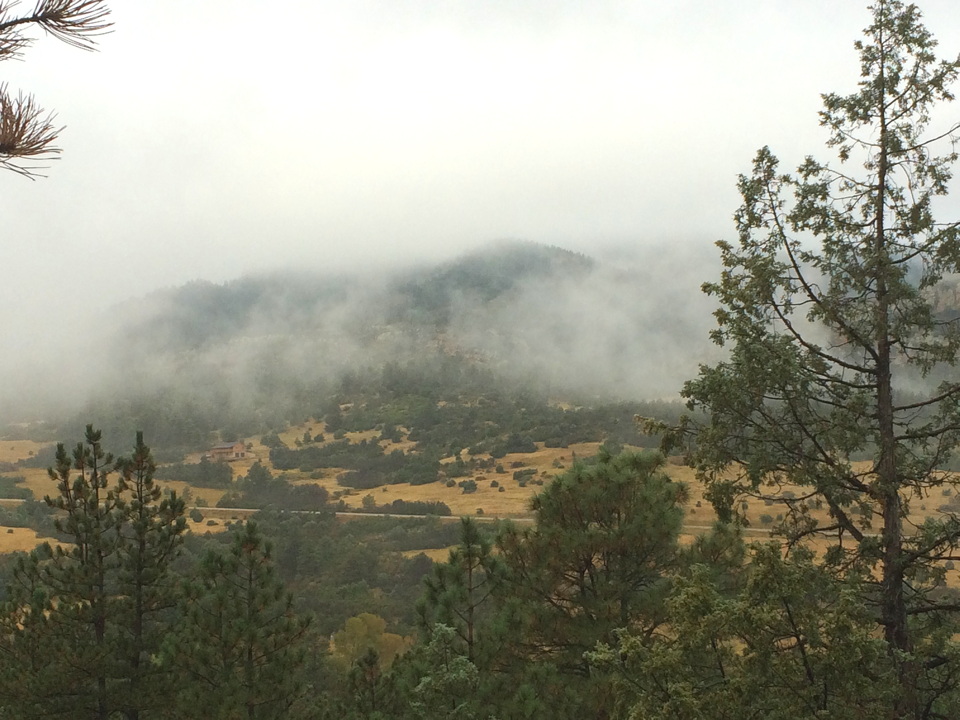The Southern Rockies are in a drought, and fire season has come early to Hardscrabble Creek.
The alarm came on Monday, and as usual, the “fog of war” (which applies in wildland firefighting too) descended rapidly.
I am part of a little rural volunteer department — secretary of the board of directors, sometimes an engine boss, sometimes just a guy with a tool in his hand.
The computerized voice on the telephone said that there was a brush fire at the intersection of County Road ••• and Highway ••. The trouble is, the county road intersects the highway twice, about two miles apart. Which one was I going to?
Dressed in interface gear (for warmth, mainly), I called the dispatcher on my radio.((The trouble is, the dispatchers all live up in the county seat, and they don’t know the roads in my part of the county very well.)) “Upper end,” she said.
M. heard me repeat that as I went out the door. Unfortunately, she did not hear the Dispatch supervisor correct the location to “lower end” as I drove away, which meant she was panicked that the fire was upwind from our house. And although I called her ten times, once I could break away for a moment, even landline calls were not getting through due to to an overloaded network. (Thanks, Century Link.)
Two of our engines were coming, but being closer, I arrived first. Some neighbors were poking at the fire with shovels, but two houses and a detached garage were in its path. Tense voices on the radio told me of the engines’ progress — it is a three-mile pull uphill from the station, and diesels don’t warm up fast.
Send the brush truck up high to “attack from the black,” I told them, and bring the tactical tender (which pumps a lot more water) down to the county road.((Some people would call that a “tanker,” but out here we use Forest Service lingo: “Tankers fly, and tenders roll”))
They did so, and before long, Chad D. was dragging a hose uphill toward the flaming oak brush behind the garage, two other volunteers assisting, while I started the pump and charged the line. In moments, our fortunes changed. We saved all the structures — and we looked good when “mutual aid” engines from two neighboring departments arrived twenty minutes later.
With the chief on the scene, I could call the dispatcher and say, “The incident commander is now Chief M., and his call sign is XXX.” Big relief.
The incident dragged into the night, and the waxing Moon was rising. Standing on that hillside, I could see scars from other fires. At least 33,000 acres have burned within a mile of my home since 2005.((That is to say, one edge of the fire was a mile away or closer.))
We have been fortunate, M. and I, but there is a psychic toll. When I went home on a supper break, she was a bundle of nerves, not sure if she was supposed to evacuate (for the third time) or not. Dog(s) . . . computers . . . favorite boots . . . we know the drill.

On the file cabinet near my desk, attached by a magnet on its back, is this rusty sardine can-and-glitter icon of the Tarot card of the World. And on the iTunes playlist when I started writing was Dead Can Dance’s “Fortune Presents Gifts Not According to the Book” (linked at the top).
I think that song is profound in a Pagan way.
Obviously, as a Pagan I do not buy into the Heaven & Hell model of the cosmos. I was exposed to the pop-culture version of Karma a long time ago, and while I think there is something to it (“The Universe rewards a right action” — does it?), you cannot look at karma as a savings account where you deposit good deeds and withdraw good fortune.
And Fortune. Or Fate(s), if you prefer. Even the gods submit to the Fates.
Driving towards the fire, I was thinking, “Is this another big one?” No, it was not. But what about the one that will come after it?
I’m a Pagan, and there is no miraculous Savior. We go out there and do our best, but even the gods submit to Fate. Meanwhile, as one of the Old Ones said,
Hige sceal þe heardra, heorte þe cenre,
mod sceal þe mare, þe ure mægen lytlað.
Thought must be the harder, heart the keener
Spirit shall be more — as our might lessens.((In a military situation, I suppose that that is what you say after you call in an air strike on your own position.))
Four volunteers and a brush truck versus fire and wind. That’s my lying-awake-at-4 a.m. worry about how it goes.
O Fortuna velut luna statu variabilis,
semper crescis aut decrescis.
The Moon rises as we walk through the burnt brush, squirting embers with a hose or breaking up a smoldering stump with a pulaski tool.
How long can this life go on?


